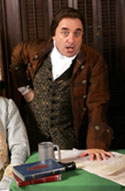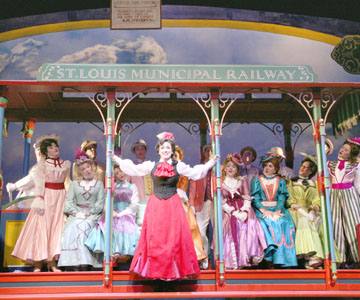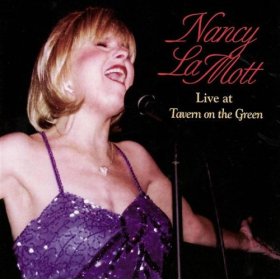Just because the Broadway strike is settled doesn’t mean I’m going to forget about all those out-of-town companies I’ve been talking up for the past few weeks. In today’s Wall Street Journal I review Goodspeed Musicals’ 1776 (in Connecticut) and Paper Mill Playhouse’s Meet Me in St. Louis (in New Jersey). Here’s a preview of the column.
* * *
 Goodspeed Musicals’ revival of “1776” was the first time I’d seen Peter Stone’s rousing salute to the Founding Fathers onstage since the original road-show version came to St. Louis 35 years ago. That production was a spectacular piece of work whose quick-change set (designed by the legendary Jo Mielziner) is still clear in my mind’s eye. I wondered how Goodspeed could squeeze the whole show onto the tiny stage of its 130-year-old theater without breaking something, but no sooner did the red-white-and-blue curtain go up on Michael Schweikardt’s handsome-looking version of the Chamber of the Continental Congress than I knew I was in good hands. Goodspeed’s “1776” is a masterpiece of compression, a production that more than makes up in stylishness for what it lacks in costly gimmickry.
Goodspeed Musicals’ revival of “1776” was the first time I’d seen Peter Stone’s rousing salute to the Founding Fathers onstage since the original road-show version came to St. Louis 35 years ago. That production was a spectacular piece of work whose quick-change set (designed by the legendary Jo Mielziner) is still clear in my mind’s eye. I wondered how Goodspeed could squeeze the whole show onto the tiny stage of its 130-year-old theater without breaking something, but no sooner did the red-white-and-blue curtain go up on Michael Schweikardt’s handsome-looking version of the Chamber of the Continental Congress than I knew I was in good hands. Goodspeed’s “1776” is a masterpiece of compression, a production that more than makes up in stylishness for what it lacks in costly gimmickry.
“1776,” of course, tells the story of the writing of the Declaration of Independence. That isn’t exactly your stock musical-comedy plot, and for all the show’s not-infrequent moments of cartoonishness, it’s gratifying to see how seriously Stone (who wrote the book) and Sherman Edwards (who wrote the songs) took their task. In between the one-liners, “1776” paints a clear-eyed picture of the hard-nosed give and take of political compromise….
 Like “1776,” Paper Mill’s “Meet Me in St. Louis” profits from being performed on a good-looking set. Rob Bissinger’s rendering of 5135 Kensington Avenue, the best-known imaginary address in Hollywood, is a life-sized, candy-colored dollhouse whose walls swing open to reveal a turn-of-the-century living room. Denis Jones’ staging of the musical numbers is equally eye-catching–I’ve never seen better choreography in a regional musical-comedy production–and the cast tears into his steps with the right mix of precision and high spirits. I wish Mark S. Hoebee, the director, had dialed down the cuteness a notch or two, but it never gets out of hand, and several of the performers, especially JB Adams and Roni Caggiano, are as good as you could possibly hope for….
Like “1776,” Paper Mill’s “Meet Me in St. Louis” profits from being performed on a good-looking set. Rob Bissinger’s rendering of 5135 Kensington Avenue, the best-known imaginary address in Hollywood, is a life-sized, candy-colored dollhouse whose walls swing open to reveal a turn-of-the-century living room. Denis Jones’ staging of the musical numbers is equally eye-catching–I’ve never seen better choreography in a regional musical-comedy production–and the cast tears into his steps with the right mix of precision and high spirits. I wish Mark S. Hoebee, the director, had dialed down the cuteness a notch or two, but it never gets out of hand, and several of the performers, especially JB Adams and Roni Caggiano, are as good as you could possibly hope for….
* * *
To read the whole thing, go here. (Please e-mail me if you have any trouble with this link!)
Archives for November 2007
CAAF: 5×5 Books of a New World Order by Calvin Baker
5 x 5 Books … is a recommendation of five books that appears regularly in this space. Today’s installment comes from an old friend of mine, Calvin Baker. Calvin’s the author of three novels, including, most recently, the magnificent Dominion, which Maud championed as one of the best books of 2006.
Whenever a certain kind of person asks me what the world beyond the post-modern looks like I usually reply that it will look like a poem or a film or a sculpture: like art; not theory. But art in America, as a rule is understood in its relationship to other forces (mercantile, political, academic, whatever), never its own primacy. It’s a situation, whatever its other advantages or disadvantages, which has engendered a conversation that has failed to understand the fundamental shift underfoot, concerning itself instead with its own self-reflective anxieties.
The truth, or closer to it, is that the next great thing is already well underway, and it is possible to point to several writers who share a concern, an opening move if not a common project, that might be described (roughly, for now) as creating narratives large enough to contain our fractured inheritances from the last epoch. While some of these writers have already been acclaimed for various aspects of the stories they’ve told, the underlying scale and import of the questions being posed — What’s Going On? — have yet to be taken up in a meaningful way.
In the meantime here are five novels of ideas (3 classic and 2 that seem destined to become canonical), each revolutionary or anti-revolutionary in a way that describes their respective ages as well as anything else. They deserve to be read, or read again, on different terms: in light of their relationship to the novel itself.
1. Buddenbrooks by Thomas Mann. When Tony Buddenbrooks, a beautiful, divorced, woman of dwindling prospects dismisses a wealthy suitor because, “Er sagt mich stadt mir” (He says who <.em>instead of whom), and it’s not the beginning of a morality tale then you know you’re in a world of the sublime. In this case it’s the fluid, intellectually sophisticated, milieu of the early 20th-century haute bourgeoisie (Bildungsburghertum), with the shadow of aristocracy on one hand, and the tenuous nature of their own position on the other.
Mann, of course, was the last European master who could act with the underlying assumption that the intellectual, political and material wants of the society he was born into shared more than physical space — that his project and the values of his culture were one — without drawing suspicion of naïveté or worse.
He continued to believe this until he was living in exile. Claiming until the last that the betrayal of the rest of the society by its political custodians was an aberration. Historians might make other claims, however, as the arcs of the 20th century played out at different paces in the European capitals, the case can still be made for Mann as the last of the great realists, trusting unmediated literary representation and inquiry to make deep sense of the world. Never mind that it was already a modernist one.
2. Invisible Man by Ralph Ellison. Ellison might be the single most important American writer of the last hundred years. Where others traded on well-established schools of thought he combined the protean modernist sensibility of Toomer with the formal perfection of the European novel to create an Erfahrungsroman for the 20th century. He is the fork in the road of American literature, one path leading to the well-behaved world of mannerism and craftsmanship, and the other diving down the rabbit hole into the gleeful madman lands of Reed and, only slightly less directly, Pynchon. Besides having a share to the claim Great American Novel, this book does even more than invent the jazz novel. This is funk before funk had a name.
3. The Alexandria Quartet by Lawrence Durrell. This is the epitome of a book whose failures show as much its triumphs. Durrell lays bear his ambition with the claim: “Modern literature offers us no Unities, so I have turned to science and am trying to complete [a novel] whose form is based on relativity. Three sides of space and one of time. … I have tried to turn the novel through both subjective and objective modes…” Post-modernism avant la letter. And that’s just the hand he reveals. Among a great many other things this is a project that also happens to be Cosmopolitan, devious (Sadian, Lawrencian, that is to say before the pill) and sexy as hell.
If his worldly gaze strikes the contemporary reader as chauvinistic, or as sharing a border of Empire with Kipling, well nothing can transcend its age entirely. Here is a writer whose meridional creativity grasps with a beautiful ease of intelligence the relationship between the fleeting and the permanent in a single sentence. Between the body, language and the fragile invisible they may sometimes express, or summon into being.
4. By Night in Chile by Roberto Bolaño, translated by Chris Andrews. Latin American artists tend to look further afield for inspiration and models than their northern counterparts. Certainly they tend to be more Europe-facing. So much so it might be argued that between the anxieties of whiteness and so-called Magic Realism the following generation had a hard time taking shape. It turns out, in the best of cases, it’s because they were out wrasslin’ with the biggest problems they could find.
For Roberto Bolaño the essential, atlas-like question is the nature of creation and the genesis of evil itself, both its personal and historical manifestations on a global scale. As might be imagined ambition like that needs a language of its own, and Bolaño creates a startling poetry to carry his meaning over.
If Bolaño is one of the great artists of his generation (and his core achievement seems to me on a level with Achebe — Sui generis), he has found in Chris Andrews the ideal translator. Where other interpreters seem to miss a beat, Andrews displays an intensity and lightness that get to the poetic and metaphysical reaches without losing, or attempting to sweep away, the spaces and silences of what cannot be translated.
5. Never Let Me Go by Kazuo Ishiguro. Post-modernism taken seriously has become the province of the grand old men, playing out the bittersweet end of what was the game of their times. It is not equal to the codes or experiences of our moment. While Coetzee — viewed with mutual suspicion by most black African writers, who suffer a different double-blind — tries to balance the equation while describing magnificently and, in the end quite revealingly, the noble and tortured last wall of the old school, several writers have already scrambled over to the other side. Among the many conceivable solutions none is quite so sly as the one offered by Kazuo Isiguruo (who shares many concerns with Coetzee, but feints to the zeitgeist as often as the canon). His deceptively simple sentences contain whole other worlds, vast unspoken epistemologies, beneath their surface. Among other things Never Let Me Go is a haunting disquisition on whether love or art can explain our world, or save us from inhuman fates.
The most frequent complaint against this book is: Why don’t they make a run for it? Opening onto the larger: Why don’t we all?
TT: Almanac
“I have always hated biography, and more especially, autobiography. If biography, the writer invariably finds it necessary to plaster the subject with praises, flattery and adulation and to invest him with all the Christian graces. If autobiography, the same plan is followed, but the writer apologizes for it.”
Carolyn Wells, The Rest of My Life
TT: By the way…
(1) Yes, we have a new toy.
(2) Yes, I’m playing with it.
(3) Yes, I’m having fun.
(4) No, I don’t know how to upload audio files yet. Don’t get greedy.
TT: Picture this
Earlier this year the soon-to-be Mrs. T and I purchased a Jane Wilson watercolor called “Breaking Light.” It was part of DC Moore Gallery’s most recent exhibition of Wilson’s work, about which I blogged here.
This is the watercolor:
A couple of weeks ago, DC Moore sent us a copy of Valerie Gladstone’s review of the show, which appeared in the March issue of ARTnews. Much to our surprise, “Breaking Light” was mentioned in the review:
Like Bonnard and Rothko, whose works resonate in a number of these paintings, Wilson employs color in various innotative ways to produce depth and create surface vitality. Her skies are so immense, they dwarf the land and sea beneath them…
The artist’s watercolors were as compelling as her oils, albeit softer and with a more liquid feeling. This was abundantly apparent in her brooding aquamarine painting Breaking Light (2003).
Pretty cool, huh?
TT: Planning ahead for Valentine’s Day
Midder Music is releasing a two-CD set of previously unreleased recordings by my old friend Nancy LaMott on February 12. It’s a sequel of sorts to Live at Tavern on the Green, the 2005 album of performances taped at her last nightclub engagement. (I wrote about that CD here.)
 Ask Me Again, the new album, will contain twenty tracks, including “Call Me Irresponsible,” “Cheek to Cheek,” “Easy to Love,” “Have Yourself a Merry Little Christmas,” “The Shadow of Your Smile,” “The Wind Beneath My Wings,” and a Stephen Sondheim medley. I haven’t heard it yet, but I heard Nancy sing most of the songs on Ask Me Again at one time or another, and I have no doubt that you’ll enjoy them now as much as I did then.
Ask Me Again, the new album, will contain twenty tracks, including “Call Me Irresponsible,” “Cheek to Cheek,” “Easy to Love,” “Have Yourself a Merry Little Christmas,” “The Shadow of Your Smile,” “The Wind Beneath My Wings,” and a Stephen Sondheim medley. I haven’t heard it yet, but I heard Nancy sing most of the songs on Ask Me Again at one time or another, and I have no doubt that you’ll enjoy them now as much as I did then.
In addition to the CD, Midder also plans to release a companion DVD called I’ll Be Here With You: A Collection of Rare Live Performances 1978-1995. Among other things, it will include a version of “Moon River” that Nancy sang on The Charles Grodin Show nine days before her death in 1995.
For more details, go here.
TT: So you want to see a (post-strike) show?
It’s true! It’s true! The Broadway stagehands’ strike has been tentatively settled. Some shows are expected to reopen immediately, but few specific details were available as of late Wednesday night, though it’s generally expected that virtually all shows will be up and running by the weekend.
One show, Chicago, is offering a one-time cut-rate ticket price of $26.50 for Thursday night’s performance, available only at the box office. I’ll update this posting throughout the day with news of any similar offers. (As of noon today, no other shows have announced discounts for tonight’s performances.)
In the meantime, here’s my list of recommended Broadway, off-Broadway, and out-of-town shows, updated weekly. In all cases, I gave these shows favorable reviews in The Wall Street Journal when they opened. (I like Chicago, too, but I haven’t seen the Broadway production since 2005 and can’t tell you what shape it’s in now.)
For more information, click on the title.
Warning: Broadway shows marked with an asterisk were sold out, or nearly so, last week.
BROADWAY:
• Avenue Q (musical, R, adult subject matter and one show-stopping scene of puppet-on-puppet sex, reviewed here)
• A Chorus Line (musical, PG-13/R, adult subject matter, reviewed here)
• The Drowsy Chaperone (musical, G/PG-13, mild sexual content and a profusion of double entendres, reviewed here)
• Grease (musical, PG-13, some sexual content, reviewed here)
• Rock ‘n’ Roll (drama, PG-13, way too complicated for kids, reviewed here)
• The 25th Annual Putnam County Spelling Bee * (musical, PG-13, mostly family-friendly but contains a smattering of strong language and a production number about an unwanted erection, closes Jan. 20, reviewed here)
OFF BROADWAY:
• The Fantasticks (musical, G, suitable for children old enough to enjoy a love story, reviewed here)
• The Glorious Ones (musical, R, extremely bawdy, closes Jan. 6, reviewed here)
• Things We Want (drama, R, adult subject matter, closes Dec. 30, reviewed here)
CHICAGO:
• A Park in Our House (drama, PG-13, adult subject matter, closes Dec. 9, reviewed here)
• What the Butler Saw (comedy, R, extremely adult subject matter, closes Dec. 9, reviewed here)
CLOSING SOON IN NEW YORK:
• Pygmalion * (comedy, G, suitable for mature and intelligent young people, closes Dec. 16, reviewed here)
TT: Almanac
“The secret of biography resides in finding the link between talent and achievement. A biography seems irrelevant if it doesn’t discover the overlap between what the individual did and the life that made this possible. Without discovering that, you have shapeless happenings and gossip.”
Leon Edel, interview in Writers at Work, Eighth Series
